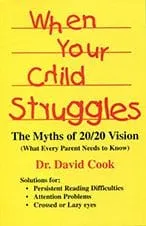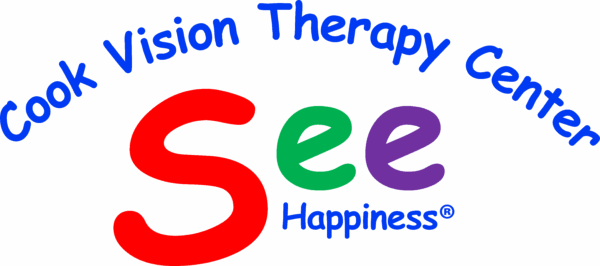Strabismus Therapy (Crossed Eyes) in Atlanta
What Causes Strabismus?
Each eye has seven muscles, six on the outside of the eyeball and one on the inside. The outside muscles move the eye. The inside muscle keeps things clear. Occasionally, Strabismus is caused by a “damaged” outside eye muscle. Usually, however, an eye deviates because the BRAIN fails to coordinate the twelve out-side-of-the-eyeball muscles to correctly position the two eyes.
The reason for this lack of coordination is, as yet, unknown. Sometimes the condition runs in families. Sometimes a child has many other developmental problems such as poor speech or deficient eye-hand and eye-body coordination and the strabismus seems to be another symptom of this general coordination problem.
Non-Surgical Strabismus Treatment
With Straight Eyes AND 3D Vision!
“Before vision therapy my left eye was stuck over near my nose, and because of that I was very embarrassed and had low self-esteem. My right eye was very tired and both eyes were red all the time. Since therapy, both eyes are straight and clear. I am no longer embarrassed and am happy to interact with other people because I don’t have to worry about what my eye is doing or what they are thinking about my eye.”
3D Vision
How a child looks does not necessarily reflect how the child sees. Often, surgery creates a false sense of security: the eyes are cosmetically aligned, but 3D Vision is still poor or absent. For this reason, we recommend a 3D evaluation for all patients who have had strabismus surgery in the past, even if the eyes now appear normal.
The brain should combine the information from the two eyes. We call this process fusion. Fusion is the glue that holds the eyes in alignment. The better the 3D vision is, the stronger the fusion is. Without fusion, strabismus surgery is merely cosmetic, and the need for multiple surgeries increases.
When successful, the latest technologies in 3D strabismus treatment allow drivers to drive, golfers to golf, hitters to hit, and learners to learn: all in a more stable, predictable 3D world.
Non-Surgical Treatment
Our treatments may include glasses and vision therapy: a kind of biofeedback that uses 3D vision to increase eye-brain coordination and align the eyes. If surgery is necessary as part of the treatment, then we refer. Our goal is to decrease the number of surgeries to a minimum and to increase two-eyed coordination and depth perception for easier learning, driving, and sports.
Treatment Age
We work with adults and school-age children. Because vision therapy requires a degree of cooperation and understanding, we typically do not see children under the age of five for in-office vision therapy. Depending on the circumstances, we may see younger children and suggest home activities, but only if the child has already been examined by a pediatric ophthalmologist and the parents are fully committed to working with the child at home.
Understanding Strabismus and Its Impact
Strabismus occurs when one eye turns inward, outward, upward, or downward, disrupting the brain’s ability to merge images from both eyes. This misalignment can cause:
-
Double or blurred vision
-
Chronic eye strain and headaches
-
Amblyopia (lazy eye) in children if untreated
While congenital cases are common, strabismus can also stem from trauma, neurological disorders, or uncorrected refractive errors. Early intervention is critical to prevent permanent vision loss.
Vision Therapy: A Non-Surgical Treatment for Strabismus
Vision therapy is a customized program combining eye exercises, prism lenses, and digital tools to strengthen communication between the eyes and brain. Unlike surgery, which adjusts eye muscles physically, vision therapy addresses the root cause by enhancing neurological control over eye alignment. Studies, including a 2022 trial in Optometry and Vision Science, report over 70% success rates in improving eye coordination through structured therapy.
Key benefits include:
-
No downtime or surgical complications
-
Personalized plans for children and adults
-
Sustainable improvements in binocular vision
For lasting results, consult a board-certified vision therapy specialist to explore whether this non-surgical approach aligns with your needs.
How Vision Therapy Corrects Strabismus: 4 Key Mechanisms
Vision therapy addresses strabismus by targeting eye-brain coordination, muscle strength, and neural adaptability. Here’s how it works:
-
Strengthening Eye Muscles
Targeted exercises like pencil push-ups (focusing on a slowly moving object) improve ocular muscle control, enabling better alignment of misaligned eyes. -
Enhancing Binocular Vision
Activities such as 3D stereogram training teach both eyes to work in sync, resolving double vision and restoring depth perception for daily tasks like driving or reading. -
Rewiring Neural Pathways
By leveraging neuroplasticity, therapy retrains the brain to process signals from both eyes simultaneously, critical for merging images into a single, clear view. -
Gradual Skill Progression
Programs start with simple tracking exercises and advance to complex tasks (e.g., shifting focus between near/far objects), ensuring sustainable improvements in visual function.
Who Benefits Most from Vision Therapy?
Vision therapy is effective for children and adults, with outcomes tailored to age and condition severity:
-
Children: Early intervention (ages 3-8) capitalizes on developing neural pathways, often achieving permanent corrections for issues like accommodative esotropia.
-
Adults: While progress may take longer, adults benefit from improved alignment and reduced symptoms in conditions like intermittent exotropia, thanks to disciplined adherence to therapy.
Best for: Intermittent exotropia (outward-turning eyes), accommodative esotropia (inward-turning due to focusing strain), and convergence insufficiency.
How Effective Is Vision Therapy for Strabismus?
Vision therapy is clinically proven to improve eye alignment, binocular vision, and daily visual function. Studies, including a 2023 Journal of Vision Development meta-analysis, show 65-80% success rates for strabismus patients, especially when paired with glasses or patching. Key benefits include:
-
✅ Improved eye coordination: Reduces double vision and enhances focus accuracy.
-
✅ Stronger depth perception: Critical for tasks like driving or sports.
-
✅ Reduced surgical reliance: Prevents or complements surgery by addressing neuromuscular root causes.
However, success requires consistent effort: results often take 6-12 weeks to manifest, with full improvements seen after 6-12 months of structured therapy.
What Does a Vision Therapy Program Involve?
1. Initial Evaluation
A comprehensive eye exam by a board-certified optometrist assesses:
-
Eye alignment and tracking ability
-
Binocular vision deficits (e.g., suppression)
-
Medical history (e.g., trauma, neurological issues)
A personalized plan is then created, targeting specific weaknesses like convergence insufficiency or gaze instability.
2. Therapy Exercises
Core activities focus on:
-
Eye teaming: Using tools like stereoscopes to merge images from both eyes.
-
Convergence/divergence training: Brock String exercises to control inward/outward eye movements.
-
Focus shifting: Alternating focus between near/far objects to improve flexibility.
-
Anti-suppression techniques: Red-filter glasses to strengthen the weaker eye’s input.
3. Duration and Frequency
-
Office visits: Weekly 30-60 minute sessions with a therapist.
-
Home exercises: Daily 15-20 minute drills (e.g., pencil push-ups, computer-based tasks).
-
Progress checks: Monthly assessments to adjust difficulty and goals.
Actionable Tips for Success
-
Start Early: Children under 8 see 3x faster progress due to neuroplasticity.
-
Stay Consistent: Skipping exercises delays results—use apps or calendars to track routines.
-
Combine Treatments: Pair therapy with prescribed prism glasses or patching for amplified effects.
-
Monitor Closely: Report headaches or regression immediately to your therapist.
-
Celebrate Milestones: Small improvements (e.g., longer focus endurance) signal progress.
About Cook Vision Therapy Center
At Cook Vision Therapy Center in Atlanta, we offer non-surgical strabismus therapy with over 30 years of experience helping patients across Georgia. Our goal is to not only straighten eyes but also enhance 3D vision and eye-body coordination for school, work, sports, and driving. We address issues like headaches, eyestrain, and homework frustration while improving reading, self-esteem, and depth perception. Our therapy also focuses on aligning crossed eyes for improved appearance and social confidence, and we help patients, including those recovering from traumatic brain injuries, regain productive and fulfilling lives.
FAQs: Strabismus Therapy in Atlanta
-
What causes strabismus in Atlanta patients?
Strabismus occurs when the brain fails to coordinate eye muscles, often due to unknown causes. Genetics, developmental delays, or rare muscle damage may contribute. Early evaluation at Cook Vision Therapy Center ensures tailored treatment for improved alignment and 3D vision.
-
How does non-surgical strabismus therapy correct crossed eyes?
-
Where in Marietta, GA, can I find non-surgical strabismus treatment?
-
Why is 3D vision crucial for strabismus therapy success?
-
Who qualifies for non-surgical strabismus therapy at Cook Vision Therapy Center?
-
Will vision therapy eliminate the need for strabismus surgery?
-
What causes strabismus in children?
-
How can non-surgical therapy improve 3D vision?
-
Where is strabismus treatment available near Marietta, GA?
-
Why choose Cook Vision Therapy Center over surgery?
-
Who should consider vision therapy for crossed eyes?
-
Will adults benefit from strabismus treatment?
-
Can vision therapy cure strabismus completely?
-
Is vision therapy painful or risky?
Check Out Our Resources
Dr. Cook’s Publications:
- Authored books VISUAL FITNESS and WHEN YOUR CHILD STRUGGLES.
- Published articles in top optometric journals.
- His article “Eyesight, infinity and the human heart” was voted “Best Non-Technical Article” by the Association of Optometric Editors.





